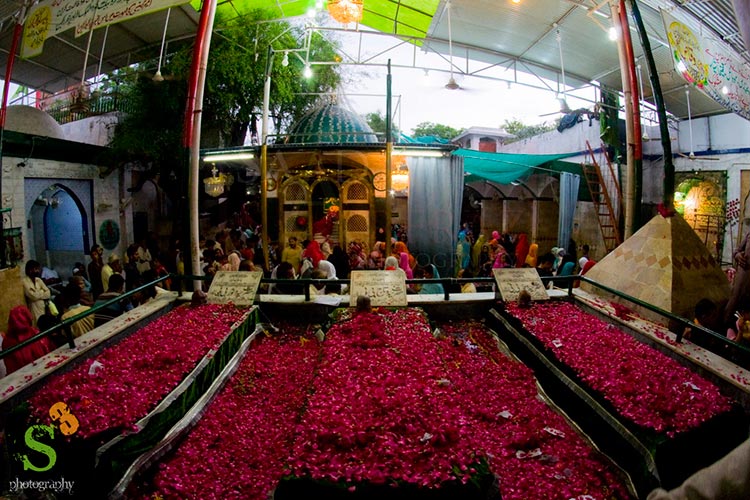Bibi Pak Daman (source: Flickr Saad Sarfraz Sheikh)Written by: Uzair Ali Khan
There are several myths surrounding the origins of Bibi Pak Daman. The name literally means, a ‘lady of purity.’ Legend claims that the shrine is the last resting place of Hazrat Ruqayyah, a daughter of Imam Ali (A.S), and five other revered women. The women are said to have fled Karbala and reached Lahore, where the Raja of the region summoned them. As women observing purdah (veiling), they could not allow this and prayed for God’s mercy which resulted in the earth opening up and burying them. Others relate that the shrine is so ancient, that Hazrat Data Ganj Bakhsh, known as the patron-saint of Lahore, was himself a devotee here – a board proclaiming this has been installed in the vicinity to give the tale an authoritative touch.
Alternatively, scholars claim that the six graves are of the six daughters of Syed Ahmed Tokhta, who lived in Lahore in the 12th century. His shrine exists to this day in Mohalla Chahaal Bibian, Walled City of Lahore. In this case the name Bibi Pak Daman, refers to the unmarried sisters. From here on, the tale adopts a similar vein to the myth, as it is said that to protect themselves from the Afghan invader, Sultan Jalaluddin Khurasani, the women’s prayers to be buried alive were answered.
A narrow street lined with shops selling flowers, religious books, chadars (sheets) with religious inscriptions and souvenirs, leads to the shrine itself. It is not the wares on offer in this street, but rather the expressions of the people, full of hope and sincerity, which make a mark on us. In present times, the shrine is popularly known as a rare unification point not only for Muslims of different sects, be they Shia or Sunni, but also for people of different religions, such as Hindus, Christians and Sikhs. The public gathers here in droves every day, and especially on the days of the Urs.
In order to reach the main building, we pass through two metal detectors, before being frisked rather carelessly by an elderly gentleman. Spread over a small area of 1000 sq. yards, Bibi Pak Daman comes across as quite crowded, with devotees on every inch of space. As I later found out, the Punjab government plans to expand it as they recognize its great popularity among people. Devotees immediately take off their shoes on entering the main compound, and we followed suit. Some devotees seem to have been living here, for they have their carpets spread out underneath. We then perform ablution at the taps, barely registering the icy cold water, as we are enamored by the shrine’s aura.
Inside, the aroma of roses is overpowering as every grave is covered with them. Having been to Data Darbar, I am surprised that devotees are not being separated based on gender. One area seems specifically for Shias, as it has an Alam – a customary silver emblem in the shape of a hand, symbolizing Hazrat Ghazi Abbas’s (R.A.) flag in the battle of Karbala – and oil lamps, but otherwise there are no designated areas for different sects. Some trees located in the courtyard attract my attention and a woman relates that these were the camels of the buried women, which changed shape to shelter their graves.
Luckily, we also come across a manqabat-khwaan, a man who recites Sufi poetry praising Ali (R.A.). The verses are powerful beyond measure and we listen entranced. After a while, we observe people rushing towards langar (free food from the shrine’s kitchen) being distributed through a small window. One individual sweeping the white marble floor tells us that naat recitals (poems praising Muhammad (p.b.u.h.)) also take place here, and majalis (congregations) are the norm.
After offering prayers, I make my way through throngs of people to the wall of the central shrine. Here, devotees cling to the gate, tie pieces of cloth and locks to the spaces in the walls, and all the while speak of their worries and desires to Allah. Some pray for health, others for progeny, and then there are some lost souls brought here by destiny. These bearded men with their matted hair and long strings of beads, walk around handing niyaz (sweets) to anyone who will take it.
It’s getting quite late and as we decide to take our leave, I glance one more time at the grandiose mausoleum. Devoid of marvelous domes, the kind which most shrines have, Bibi Pak Daman still has an imposing aura. Its ability to bring together such diverse people is a testament to its power. Perhaps, entry to such a place requires not just ablution of the body, but of the soul as well.
https://www.youlinmagazine.com/story/the-shrine-of-bibi-pak-daman/ODkw





 /2.0 AFD DC
/2.0 AFD DC